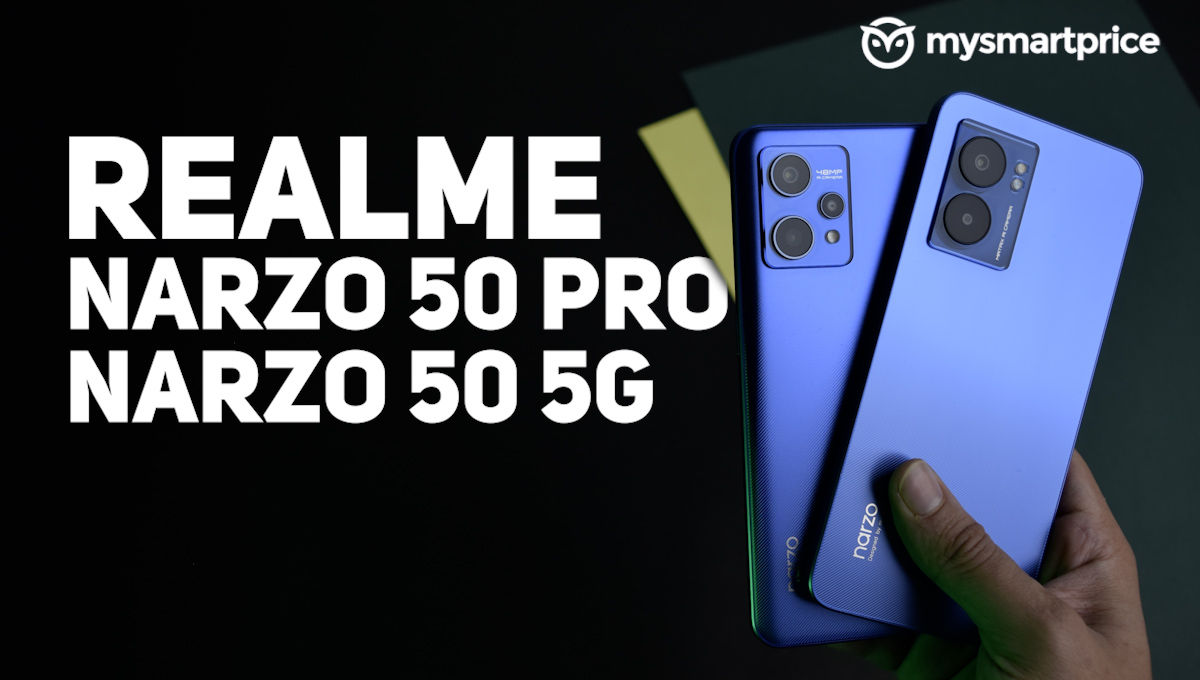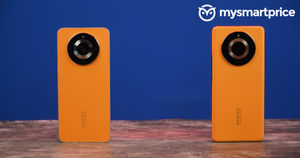
Realme’s latest entries in its Narzo 50-series are the Narzo 50 5G and the Narzo 50 Pro 5G. Sure, the confusing nomenclature from Realme doesn’t seem to end anytime soon, but the two smartphones seem promising when you consider the price-to-specs ratio of the two smartphones.
Starting at Rs. 15,999, the Narzo 50 5G seems to be Realme’s new deal king on Amazon, as its first sale was studded with discounts and offers. The Narzo 50 Pro 5G, on the other hand, seems to be the company’s new mid-range champ. Priced at Rs. 21,999, it’s going up against the likes of the Redmi Note 11 Pro+, Nord CE 2 and even higher-priced options such as the Vivo T1 Pro and Iqoo Z6 Pro.
While this was the preface, which phone is the right fit for you and how much value does the extra Rs. 6,000 get you? Read our combined review of the two phones to find out.
Design and Build
Realme Narzo 50 5G
Although the Realme Narzo 50 5G is the more affordable smartphone among the two, it offers a more modern design. So you get a flat frame and rear panel, mimicking the design trends set by the flagships of 2022. The frame and rear both are made of plastic, the back has a nice frosty finish to it, and the frame has a matte finish, and I dig both of these.
 But the rear is a fingerprint magnet, so if you get irked by an unclean phone, you may want to use a case. The button placement is very Realme. On the left, you have two volume rockers, whereas the right of the phone hosts the lock button with an embedded fingerprint scanner.
But the rear is a fingerprint magnet, so if you get irked by an unclean phone, you may want to use a case. The button placement is very Realme. On the left, you have two volume rockers, whereas the right of the phone hosts the lock button with an embedded fingerprint scanner.
I didn’t like the tactile feedback of the lock button, as it is recessed and requires a hard press to activate it. The fingerprint scanner, too, was a hit-and-miss affair for me, registering my inputs successfully about seven times out of ten.
The bottom of the phone houses all of your wired connectivity options – the USB Type-C port and the headphone jack.
The camera module is a transparent plastic slab that protrudes a little from the rear panel. Two symmetrical camera units sit in a vertical configuration within it with dual LED flashes on the side. It induces a bit of a wobble, but typing with the phone resting on the surface is not a nuisance.
Although the phone doesn’t have any official IP rating, the hybrid dual SIM tray has a rubber seal that keeps the water from entering the phone.
Overall, in terms of design, I’m pleased with the way Narzo 50 5G manages to look modern and slick without being obnoxious.
Realme Narzo 50 Pro 5G
The Realme Narzo 50 Pro 5G follows a similar design philosophy but with a curved rear panel. This allows for a more confident feel in hand. The choice of materials for the frame and the rear are the same as the Narzo 50 5G, but the texture is ever so slightly different. The 50 Pro has a more metallic shimmer instead of a frosty finish.
Because of the curved rear, the frame is much narrower than the Narzo 50 5G, and the buttons (placed in the same way) protrude more prominently. Also, the lock button here isn’t recessed because the fingerprint reader is under the display and is much easier to depress. The bottom of the Narzo 50 Pro 5G has the same ports in the same configuration as the Narzo 50 5G.
Overall, I feel more comfortable using this phone compared to its sibling, despite having a slightly dated design.
Display
Realme Narzo 50 5G
At the front, the Realme Narzo 50 5G is lit up by a 6.6-inch LCD display with Full HD+ resolution (1080 x 2408). It has a refresh rate of 90Hz and an aspect ratio of 20:9. It has a peak brightness of 600 nits.
Being a budget smartphone, the display is just good enough to use outdoors as well as for casual use. Just don’t expect it to be super responsive while gaming or scrolling. It does have Widevine L1 certification that allows it to stream HD content from apps like Netflix and Prime Video, but there’s no HDR and Dolby Vision certification.
Accompanying the display, there is a single speaker output on the bottom. It can get loud, but it lacks the depth and punchiness of more expensive smartphone speaker systems.
I’ve played games, watched movies, TV series, and scrolled some social media with it, and it’s been a mixed bag. Most of the content I watched on YouTube, Hotstar, Netflix, and Prime Video looked fine, but it struggled quite a bit when it came to dark scenes. The responsiveness honestly depends on the mood of the phone, and it can be annoying at times. The viewing angles are acceptable, and colour shifting is also prominent.
For a phone worth Rs. 15,000, it performs fine, although there are phones with better displays out there at the same price, such as the Poco M4 Pro 5G.
Realme Narzo 50 Pro 5G
The Narzo 50 Pro 5G boasts a nice, vibrant 6.4-inch AMOLED display with Full HD+ resolution and 90Hz refresh rate. On paper, it’s smaller than the Narzo 50 5G, and the rest of the stuff seems similar, but in real life, the experience is far more pleasant.
 With a claimed peak brightness of 1000 nits, it is sufficiently bright under direct sunlight and is somehow more consistently responsive than the Narzo 50 5G. The colour tuning to me seemed better than the Iqoo Z6 Pro, which I recently reviewed. It is suitable for playing games on the go and watching content. The viewing angles were also decent, and only a very extreme angles does it start rainbowing out.
With a claimed peak brightness of 1000 nits, it is sufficiently bright under direct sunlight and is somehow more consistently responsive than the Narzo 50 5G. The colour tuning to me seemed better than the Iqoo Z6 Pro, which I recently reviewed. It is suitable for playing games on the go and watching content. The viewing angles were also decent, and only a very extreme angles does it start rainbowing out.
It doesn’t have HDR10+ certification but has Widevine L1 certification for HD streaming. Interestingly, I couldn’t find the Netflix app on Google Play with the Narzo 50 Pro 5G, but it might be because I had a pre-production unit. Do keep an eye out for this space, as I’ll update it soon for Netflix availability.
Overall, the Narzo 50 Pro 5G display is marginally better than what the competition has to offer, and I was mostly happy with it.
Performance
Realme Narzo 50 5G
The biggest selling point of the Narzo 50 5G is, well, 5G! The MediaTek Dimensity 810 SoC powers it. It comes in three variants of 4GB/64GB, 4GB/128GB and 6GB/128GB which are priced at Rs 15,999, Rs 16,999 and Rs.17,999 respectively. All this runs atop the Realme 3.0, which is based on Android 12 with the April 2022 security update. Realme is promising two years each of Android firmware and security updates. Oh, and it also comes with a ton of bloatware.
In real-world use, the phone is somewhat snappy to use, but you will observe some stuttering every now and then. However, the lack of optimisation in notifications and commonly used apps like Instagram makes it a bit disappointing to use. Notifications aren’t ranked properly by default, missed calls are stacked at the bottom, and WhatsApp notifications appear weird and janky. I had to keep restarting Instagram because key UI elements like the Direct Message button or the entire bottom bar would disappear. The phone also ships with a ton of bloat, and the spam notifications from the browser app can be creepy at times.
 The phone is suitable for casual gaming, so don’t expect to play heavy titles on high graphics with this phone. Call of Duty maxes out at medium, and frame rate also defaults at medium. The experience was mostly okay, and there were a few stutters here and there. More toned down titles, like Egg Inc. and Plague Inc., worked without issues.
The phone is suitable for casual gaming, so don’t expect to play heavy titles on high graphics with this phone. Call of Duty maxes out at medium, and frame rate also defaults at medium. The experience was mostly okay, and there were a few stutters here and there. More toned down titles, like Egg Inc. and Plague Inc., worked without issues.
I wasn’t able to check out the core offering of the performance package, though – 5G. On paper, you get seven 5G bands (n1/n5/n8/n28/n41/n77/n78). But there’s no way to try it out in India. I am guessing squeezing in a 5G modem in such a tightly specced SoC might be the reason for most of its performance woes. But there’s no way to verify it.
Realme Narzo 50 Pro 5G
The Realme Narzo 50 Pro 5G is powered by the MediaTek Dimensity 920 SoC, which is a tried-and-tested workhorse. Several top-selling Realme and Xiaomi phones use it, and it has a track record of performing reasonably decently in the price bracket. The phone comes in 6 and 8GB RAM variants, whereas storage remains constant at 128GB.
Realme has tried to undercut its rivals with this processor, and I think it’ll work well for them. Sadly, I wasn’t able to run AnTuTu Benchmark 9 on this due to a parsing error, but other tests such as Geekbench 5 and 3DMark yielded scores that were at par with its rivals.

Moving aside from benchmarks, the smartphone performed well when using work and messaging apps such as Slack, Gmail, WhatsApp and Basecamp. In addition, social media apps such as Instagram and Facebook were well optimised for the phone, unlike the Narzo 50 5G. The notification issue was still there but wasn’t as glaring as the former.
I compared the gaming performance to the Iqoo Z6 Pro by playing Call of Duty Mobile and a little bit of Genshin Impact, and it was in the same league. Call of Duty Mobile ran at High graphics and frame rate settings without much stuttering, but I observed a bit of sluggishness while playing Genshin Impact.
The UI experience otherwise was very similar to that of the Narzo 50 5G, even though there were times when I felt it was slightly modified. For instance, the maximum volume would go only up to 100%, whereas the Narzo 50 5G at least claimed to boost it to 200%. These might just be there for placebo purposes, but it does reveal the difference in the two phones’ UI despite running the same version.
Camera
Realme Narzo 50 5G

The Narzo 50 5G has a straightforward camera configuration, one 48-megapixel primary shooter paired with a 2-megapixel depth camera. Given the price and the sensor, the camera can take some good shots during the day and night. But on closer inspection, I could see that the images lacked clarity.
In this shot of Qutub Minar during sunset, the textures on the walls and Minar were nicely captured, but the colours were a bit washed out. This is because the blue in the sky was two shades lighter than reality.
The HDR can be a little too aggressive. In this shot, with really bright sunlight on the right and contrasting colours of red, blue and green, it’s clear that the HDR was struggling to retain the highlights and depth of colours on the Minar. The red was too saturated to my taste.
The night shots were good given the price of the phone. In this shot with contrasting street lights, the sensor captured the scene well and took about a couple of seconds to process the shot. The noise levels seemed acceptable, but the photos were slightly toward the warmer colour temperature.
The selfie camera can take good selfies outdoors but struggles indoors. As is the case with rear cameras, HDR can be a little too aggressive here.
Realme Narzo 50 Pro 5G
The Narzo 50 Pro 5G has a triple camera system, with 48-megapixel primary, 8-megapixel ultrawide and 2-megapixel macro shooters. The addition of the ultrawide is welcome, even though it struggles with capturing details, but the macro, at least according to me, is just an addition to increase the camera count.
The results from the primary camera were very similar to that of the Narzo 50 5G, showing similar aggression with HDR and red tones.
The ultrawide camera actually has a more neutral tone and doesn’t shift so dramatically to reds.
The selfies taken from the camera carry much more detail than the Narzo 50 5G, but when it applies HDR, it can make you appear disconnected from your background because of how much processing it does.
The night shots were mainly similar to the Narzo 50 5G, except the night sky was way more natural.
In portrait mode, the defocus effect was too prominent, but it can be reduced or increased later on. The subject separation is average, and it gave me one of the funniest portrait artefacts in which a person behind my elbow was in crisp focus.
Overall, the camera package of both phones is passable, but the addition of the ultrawide camera makes the Narzo 50 Pro a lot more practical.
Battery
Realme Narzo 50 5G
Backing the Narzo 50 5G is a massive 5,000mAh battery which can be charged via the provided 33W Dart Charger. The claimed charging times of 70 minutes are somewhat true in real-world situations. With three measured charging attempts, I was able to go from about 2% battery to 100% in about 1 hour and 15 minutes on average. The phone heats up ever so slightly while charging, but it’s not enough to slow down the entire process by a significant amount.
I was able to get about seven and a half hours of screen-on time, and when I used the phone mildly, I could stretch it for just a little over a day. I’m assuming the lack of an AMOLED display and in-display fingerprint sensor helps reduce battery drain.
Realme Narzo 50 Pro 5G
The Narzo 50 Pro 5G also comes with the same 5,000mAh battery pack and 33W Dart Charger as its sibling, but it has a slightly lower screen on time of about 6.5 hours. The charging time was roughly the same, though, but by the time the clock struck 10 pm, I had to start looking for a wall socket to plug the charger.
Compared to high wattage chargers that heat up significantly and bring down charging times to protect the device, I’m more than happy to have a more predictable charging experience that allows me to plan my day.
Realme Narzo 50 5G, Narzo 50 Pro 5G Review: Verdict
Given the aggressive pricing of the new Narzo 50 5G and Narzo 50 Pro 5G, I think Realme’s latest offerings might be attractive to a lot of buyers. But to me, the Narzo 50 Pro 5G is a much, much better deal. It is priced lower than the recently launched Iqoo Z6 Pro, Vivo T1 Pro, and even the OnePlus Nord CE 2, but it can deliver performance that’s almost at par with the lot. The only other phone that offers marginally better value, at least on paper, is the Redmi Note 11 Pro+.
The Narzo 50 5G finds itself in a tough spot as it tries to compromise on things like a responsive display and raw performance to make room for a 5G modem while being on a budget. But if you want to be future proof as and when 5G comes to India, you can consider it.
I would have loved to have a better UI experience on both smartphones, especially notifications and app optimisation.









































